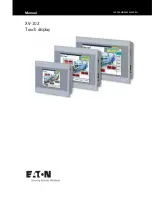
36
3M™ Multi-Touch Chassis Display User Guide
3M Touch Systems, Inc. Proprietary Information -- 37732v04
3M Touch Systems recommends that the touch driver generate an interrupt as each packet
in the data stream arrives. Because touchdown and liftoff events are specially coded, your
software can generate mouse events that correspond to what the user is doing. This
enables instant feedback and prevents data loss.
Communicating with the Controller
This section provides information on sending firmware commands to the controller and
interpreting the responses that the controller returns.
The commands listed in Table 18 are those that 3M Touch Systems currently uses for
development. 3M Touch Systems recommends that you use only these commands for
3M™ PX serial controller development.
Commands to the controller are sent on the signal
Receive Data
(RXD) line as a serial
data stream. For each command it receives, the controller sends a response to the host on
the signal
Transmit Data
(TXD) line also as a serial data stream.
Sending Commands to the Controller
When you send a command to the controller, you must use the correct command format.
The general format of a command is as follows:
<Header>Command<Terminator>
Note:
The following descriptions of header, command, and terminator, use 3M Touch
Systems terminal emulator key sequences. You may need to enter the sequence in a
different format, depending on your emulator.
The
header
is the first character in the command string and is the ASCII start-of-header
control character SOH. The hexadecimal code for the ASCII SOH control character is 01.
To start the command sequence, use the key combination Ctrl A (^A). If you are working
with an IBM PC compatible system, the Ctrl A key combination immediately returns an
ASCII
☺
character.
The
command
, which always follows the header, consists of ASCII uppercase letters and
numbers only (printable characters).
The
terminator
is the last character of each command string and is an ASCII carriage
return CR. An ASCII CR control character is 0D hexadecimal. To enter a carriage return,
ending the command sequence, use Enter or the key combination Ctrl M (^M).
This appendix lists each command as a string of ASCII control characters and printable
characters consisting of a header, the command, and a terminator as follows:
<SOH>
Command
<CR>

































